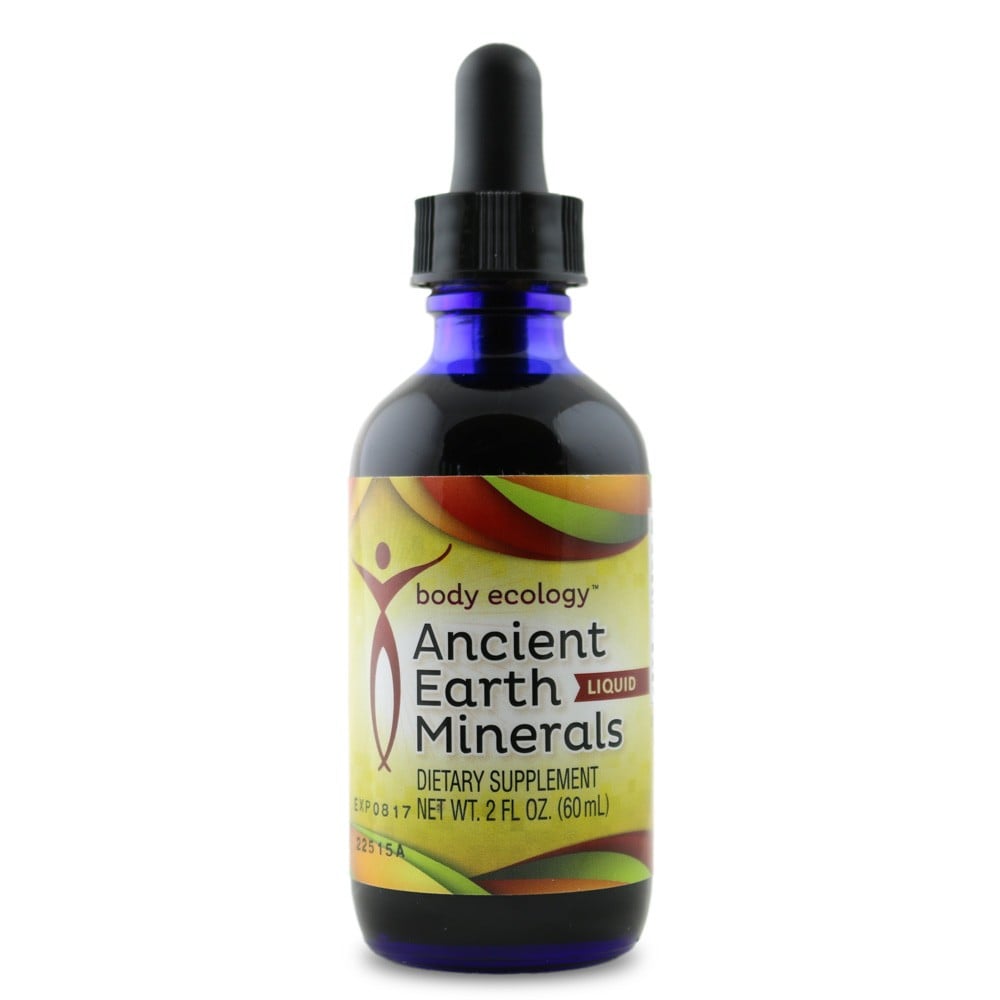
Can you reverse gray hair? 4 natural ways to turn back time
It was over 100 years ago that Dr. Élie Metchnikoff noticed that in cultures where people ate fermented foods, they aged better. Metchnikoff, a Russian-born microbiologist and zoologist known as the “Father of Natural Immunity,” put his observation to the test.1
Some signs of mineral deficiency include dry skin, fatigue, constipation, and gray hair. If you have prematurely gray hair, your body may need more humic minerals to help reduce or reverse visible signs of age.
With this simple practice, and based on his research, Dr. Metchnikoff regularly ate fermented foods and lived into his seventies, which, in those times, was a very long life.
Also a Nobel Prize winner, Dr. Metchnikoff was one of the first scientists to discover and reap the benefits of eating fermented foods.
For a short time, Dr. Metchnikoff’s probiotic “theory” — that good bugs could improve health and keep the mind sharp with age — stayed at the forefront.2 But it wasn’t until the mid-1990s that a fervor for all things fermented returned to the scientific community.
Body Ecology founder Donna Gates believes that the way she eats, with fermented foods being a staple of her diet for more than 25 years, has much to do with her being over 70 years old and having plenty of energy.
Donna says that she’s still flexible, and her hair hasn’t turned gray. These are some of the clear signs that she’s not aging as other people her age have, supporting why Donna doesn’t think aging is inevitable.
Most of us are aging sooner than we need to be, and it often starts with that first premature gray. Below, we’ll discuss exactly how to address this pesky problem with natural, healthy-gut remedies that can be used to improve your health and your appearance — essentially turning back time.
The top gray hair ‘fixes’: 4 natural remedies to try
The most effective anti-aging practices Donna lives by can also help to prevent, manage, and reduce hair that’s gone prematurely gray:
1. Get more humic minerals.
Minerals are a catch-all solution for many, if not all, of the symptoms of aging in our bodies:
- A deficiency in minerals may be the reason we start to get tired all the time, mistakenly attributing this decline in function to age.
- Minerals help nourish the adrenals, and the adrenals provide the body with energy to heal.
- Signs of so-called premature aging, like constipation, fatigue, dry skin, and gray hair, may actually be depletion in our prenatal jing, the constitutional energy we’re born with.
It’s possible to help replenish prenatal jing by nourishing the adrenals and thyroid with healing foods on the Body Ecology program and with ample amounts of minerals. Taking high-quality humic minerals can help nourish, detoxify, and reduce signs of aging in the body.
Humic mineral extract has a 92-percent success rate in treating a number of chronic diseases associated with age, including autoimmune diseases like rheumatoid arthritis.3
2. Focus on proper digestion + diet.
Our bodies need more help from digestive enzymes with each passing year as our naturally-produced enzymes that help us break down and process food deplete with age.
By adding in the right digestive enzymes to help promote and protect a healthy microbiome, guarding yourself against mineral deficiencies (which many are deficient in without knowing — i.e., gray hair), and choosing a diet that includes simple principles of proper eating and food combining to rebalance your internal ecology, your body gets what it needs from the inside out.
Including the catalase enzyme can also help to bind to hydrogen peroxide in the body, turning it into CO2 and water:
- While some hydrogen peroxide in the body is necessary — required by the thyroid gland to make thyroid hormone — gray hair is caused by oxidative stress created when too much hydrogen peroxide accumulates at the root of the hair follicle.4
- Flushing out this buildup of hydrogen peroxide with a catalase enzyme can help to prevent hair from bleaching itself from the inside and prematurely turning gray.
For gray hair reversal, peroxide-blocking catalase enzymes are better taken internally.
3. Try anti-aging herbs.
Fo-ti root (He Shou Wu), a member of the buckwheat family, is an anti-aging herb renowned for its fertility-boosting and hair-color restoration potential.
For cases of gray hair and balding, taking Fo-ti root can prove powerful:
- When researchers gave Fo-Ti root, administered as P. multiflorum extract, to mice, it was shown to completely reverse hair graying caused by high levels of hydrogen peroxide.5
- Fo-ti root can be taken orally to support gray hair renewal, while also reaping its liver tonic, cognitive, longevity, and energizing benefits.
This herbal adaptogen has been used for centuries in Chinese medicine, with sedative, anti-inflammatory, hypotensive, cardiotonic, and anti-tumor applications confirmed in our modern research.6
4. Always eat fermented foods.
Following the Body Ecology program is a sure path to timeless aging because it’s so mineral-rich:
- Donna says she stays very mindful of nourishing her cells since a well-nourished cell is a clean cell, and it’s going to live much longer. It’s really that simple.
- The way Donna teaches people to eat on the Body Ecology program has helped them to age beautifully.
Studies show that good gut bacteria (which can be supported by our cultured foods) can indeed influence and may slow down aging.7
“I get this a lot: ‘Wow, whatever you’re doing, it’s working. You look 20 years younger!’ – Angela.
Click here to read more about transforming your health the Body Ecology way.
The top gray hair causes: 4 habits to avoid
Gray hair can be naturally reversed, in some cases, while avoiding these common stressors can keep hair colorful for longer:
1. Eating too much meat.
High hydrogen peroxide levels, a.k.a. the internal hair-whitening agent, are common when eating excess meat:
- Gray hair has been linked to a higher heart disease risk in men.8
- Though unrelated to the gray hair findings, we know that a diet rich in processed red meat can increase the risk of heart disease and death.9
Meat can still be a healthy part of the Body Ecology program, as long as it’s unprocessed, properly combined, and makes up only 20 percent of a meal.
2. Eating too much sugar.
Many times, loss of hair volume, color, and quality can be caused by a systemic infection, like underlying candida overgrowth in the gut.
Countless people in the Body Ecology community have found that by eliminating all sources of refined sugar to help control candida, while nourishing the thyroid and balancing hormones on the Body Ecology program, hair becomes longer, thicker, and more vibrant.
3. Skipping the (fermented) vegetables.
Remember that prenatal jing we spoke of, the finite amount of energy we’re all born with that’s passed down to us from our parents and grandparents? Supporting the thyroid and the adrenals by eating daily fermented vegetables can help to offset some of the most damaging effects of our go-go-go culture.
Reducing stress to help reduce signs of aging in the body is paramount; good gut bacteria have an effect on our central nervous system and can lower stress levels and anxiety.10
4. Not getting enough sleep.
Stress, sleep, and signs of aging all go hand-in-hand:
- Donna personally lives by the rule of going to bed at 10 p.m., taking care to dim the lights and turn off her computer to prevent stimulation at least two hours before bed.
- Getting this deep and restorative sleep may be enough to work as the “fountain of youth” as we grow older; when examining restless sleep habits in the elderly, scientists have stated that almost every age-related disease has a causal link to our sleep.11
- Newer research has confirmed that stress can indeed cause gray hair and could be reversible in some people.12
If sleeping for a full seven to nine hours proves difficult, napping during the day can fill the gap, helping to protect the brain and the body from the internal damage caused by lack of sleep.
Everybody ages, and eventually, we will all have our last day on this earth, but we’re absolutely convinced that we can go right on living comfortably in these bodies if we take good care of them.
What’s on the horizon for new scientific breakthroughs that can change how we age? Only a few years ago, researchers discovered — by happenstance when studying tumors — how deleting the SCF gene could cause hair to turn gray.13 Soon enough, scientists may be able to use this information to develop a topical product that supplies us with the gene needed to keep our hair colorful.
Until then, we can continue to use all we’ve learned about our unique genetic blueprints and how they may affect our predisposition for aging and disease. With the gut-smart, gene-smart approach found in the Body Ecology program, we can influence our genetic factors, even our vulnerability to aging, by the food and lifestyle choices we make.
Here’s to aging backward!
REFERENCES:
- 1. Gordon S. Elie Metchnikoff: father of natural immunity. Eur J Immunol. 2008
Dec;38(12):3257-64. doi: 10.1002/eji.200838855. PubMed PMID: 19039772. - 2. Mackowiak PA. Recycling Metchnikoff: Probiotics, the Intestinal Microbiome and the Quest for Long Life. Frontiers in Public Health. 2013;1:52. doi:10.3389/fpubh.2013.00052.
- 3. Yuan, Shenyuan; Fulvic Acid, 4 1988; in Application of Fulvic acid and its derivatives in the fields of agriculture and medicine; First Edition: June 1993.
- 4. K. U. Schallreuter, M. A. E. L. Salem, S. Holtz, A. Panske. Basic evidence for epidermal H2O2/ONOO–mediated oxidation/nitration in segmental vitiligo is supported by repigmentation of skin and eyelashes after reduction of epidermal H2O2 with topical NB-UVB-activated pseudocatalase PC-KUS. The FASEB Journal, 2013; DOI: 10.1096/fj.12-226779.
- 5. Han M-N, Lu J-M, Zhang G-Y, Yu J, Zhao R-H. Mechanistic Studies on the Use of Polygonum multiflorum for the Treatment of Hair Graying. BioMed Research International. 2015;2015:651048. doi:10.1155/2015/651048.
- 6. Bounda GA, Feng YU. Review of clinical studies of Polygonum multiflorum Thunb. and its isolated bioactive compounds. Pharmacognosy Res. 2015;7(3):225-236. doi:10.4103/0974-8490.157957.
- 7. Bing Han, Priya Sivaramakrishnan, Chih-Chun J. Lin, Isaiah A.A. Neve, Jingquan He, Li Wei Rachel Tay, Jessica N. Sowa, Antons Sizovs, Guangwei Du, Jin Wang, Christophe Herman, Meng C. Wang. Microbial Genetic Composition Tunes Host Longevity. Cell, 2017; 169 (7): 1249 DOI: 10.1016/j.cell.2017.05.036.
- 8. “The degree of hair graying in male gender as an independent risk factor for coronary artery disease, a prospective study.” European Society of Cardiology, 2017.
- 9. Victor W. Zhong, Linda Van Horn, Philip Greenland, Mercedes R. Carnethon, Hongyan Ning, John T. Wilkins, Donald M. Lloyd-Jones, Norrina B. Allen. Associations of Processed Meat, Unprocessed Red Meat, Poultry, or Fish Intake With Incident Cardiovascular Disease and All-Cause Mortality. JAMA Internal Medicine, 2020; DOI: 10.1001/jamainternmed.2019.6969.
- 10. Daniel J. Davis, Holly M. Doerr, Agata K. Grzelak, Susheel B. Busi, Eldin Jasarevic, Aaron C. Ericsson, Elizabeth C. Bryda. Lactobacillus plantarum attenuates anxiety-related behavior and protects against stress-induced dysbiosis in adult zebrafish. Scientific Reports, 2016; 6: 33726 DOI: 10.1038/srep33726.
- 11. Bryce A. Mander, Joseph R. Winer, Matthew P. Walker. 10.1016/j.neuron.2017.02.004. Neuron, April 2017 DOI: 10.1016/j.neuron.2017.02.004.
- 12. Ayelet M Rosenberg, Shannon Rausser, Junting Ren, Eugene V Mosharov, Gabriel Sturm, R Todd Ogden, Purvi Patel, Rajesh Kumar Soni, Clay Lacefield, Desmond J Tobin, Ralf Paus, Martin Picard. Quantitative mapping of human hair greying and reversal in relation to life stress. eLife, 2021; 10 DOI: 10.7554/eLife.67437.
- 13. Chung-Ping Liao, Reid C. Booker, Sean J. Morrison, Lu Q. Le. Identification of hair shaft progenitors that create a niche for hair pigmentation. Genes & Development, 2017; DOI: 10.1101/gad.298703.117.









